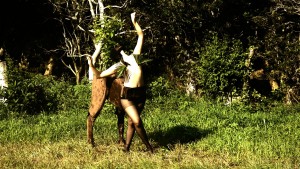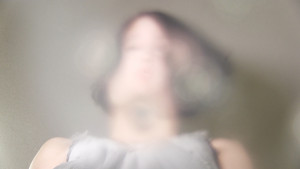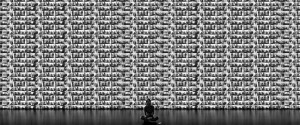オルタナティブ人形劇団「劇団★死期」,NEW ENERGY CINEMA PRADISE, 30′, 2016 ※11/12(土)のみの上映
オルタナティブ人形劇団「劇団★死期」初の映画。
The first movie of the Alternative Puppet Theatre GEKIDAN★SHIKI. The first memorable work was produced to be aimed at imposing B-movie. Your brain may be twisted a little.
西山修平, timestrip, 6′, 2016
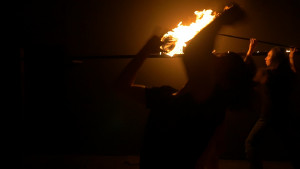
和田昌弘, Rμv-1/2gμvR=(8πG/c^4)Tμv -Single channel ver.1-, 10′, 2016 ※11/12(土)のみの上映
100年後、1000年後、10000年後、1000000000年後日本人という言葉は意味をなすのだろうか。それは宇宙にとってはどうでも良い事であるように、私にとってもどうでもよいことかもしれない。
After 100 years, after 1000 years, after 10000 years and after one billion years, would it make sense a word of Japanese? As the universe does not care it, even I may not care it, too.

韓成南, Blue Back Hole Tokyo, 6′, 2016
身重の女が日本の中心を1周した。韓成南の作品「Eveadam」を作品内作品として見せる。
Pregnant woman went around the center of Japan. She Shows Sung Nam HAN’s work called “Eveadam” as a work within the work.
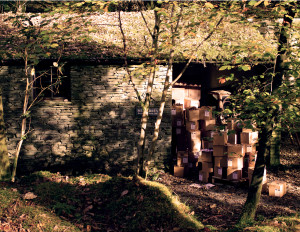
Adam CHODZKO, Knots, 8’05”, 2013 ※11/25(金)のみの上映
In Knots, Adam Chodzko focuses on the remote but important relationship between the artist Kurt Schwitters, in the final years of his life in the late 1940’s, living in poverty and exile in England’s Lake District, and J. Edgar Kaufmann, the wealthy owner of the Kaufman Department Store in Pittsburgh, USA.
Kaufmann had arranged for money to be wired to Schwitters so that he could develop a new Merz structure. Chodzko plays with the desire to conclude and tie up the loose and disparate ends of this narrative. He imagines the now empty Merzbarn (Schwitters final work having been removed to a Newcastle museum in 1965) as a vacuum, sucking in thoughts, desires and matter; all caught up in the vortex of a dream-like surreality.
Kaufmann had commissioned Frank Lloyd Wright to design his Pittsburgh office, a structure that itself was also later displaced from its source when donated to the Victoria & Albert Museum, London. Chodzko sees the interior spaces that Schwitters and Kaufmann worked within as unstable, flowing, collaged together, as though becoming a Merz themselves, whilst the form of the video also echoes this process of construction and deconstruction.
いつも早朝、夜遊びが終わった後、女は二日酔いで超高層ビルの建設現場に来る。
その背後には巨大にそびえ立つ都市。
彼女は、着飾った服のまま、疲労と苦しみを抱えているようだ。
よくある早朝、彼女はいつもの出来事を語り始める…
彼女は都市。
As every early morning, after the city nightlife as died, a woman come in a skyscraper construction site to tell her hangover.
The city behind them appears gigantic.
She has Sunday clothes, she looks tired and hurt.
Like every early morning, she start to narrate her daily cycles…
She is the city.
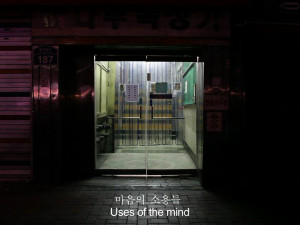
Mihye CHA, Gazing at Kim, 5’39”, 2015 ※11/25(金)のみの上映
*Gazing at Kim
1人のアーティストまたは匿名の名もなき人の眼差しとイメージのポートレートである。
私は、鍾路(チョンノ)の古い劇場で1989年3月の早朝に亡くなっているのを発見された、1人の詩人の最後の日を想像した。
それは、彼が作品に生きる意味を描き、不確かな目的地へ到達するために不安やフラストレーションをかかえながらも、とらわれない生き方について考え、やがて最後の瞬間に導かれた先が「劇場」であることを象徴的に感じた。
彼の作品とそのフレーズが持つ感情と街をイメージのベースとし、映像では詩人が散策したであろう鍾路(チョンノ)の通りにある幾つかの場所、雰囲気や変わらない街の風景を見せている。
私は、何かを見つめることを主張する心と詩の断片的に引用したテキストから、人々の内なる声がランダムに交差し、すれ違う時空間について表現した。
*このフレーズは、キ・ヒョンド「The Hope of 4 in the Afternoon」より引用
*キ・ヒョンドは 、鍾路(チョンノ)のかつて長編二本立てを上映していたパゴタ劇場で、1989年3月7日に亡くなった。
*Gazing at Kim
Portrait of one artist or anonymous stranger’s gazes and images.
I imagine one poet*’s last day of his life who was found dead in the early morning of Mar. 1989 in an old theater in JongRo.
It felt symbolic that it was a ‘theater’ that he headed at his last moment while thinking about anxiety, frustration, meditation and will of life described in his works and nomadic attitude to reach unclear destination. Based on the image of city and emotions brought by his works and phrases, video shows the city view where the images of something remained unchanged or not as well as allies and streets of Jongro that the poet would have strolled at some point.
I would like to describe spatio-temporality that is crossed and met by internal narration of random individual by duplicating fragmentary texts and movements of someone’s mind which insists to gaze at something.
*The phrase cited from the poetry, The Hope of 4 in the Afternoon by Ki Hyoung-Do
*Hyeongdo, Ki died on Mar 7th, 1989 at Pagoda Theater which used to be a double featured theater in Jongro.
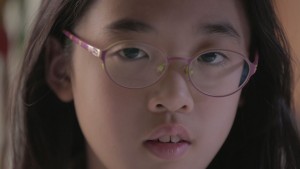
Sook Hyun KIM, You’d be Nowhere, 26’30”, 2016 ※11/12(土)のみの上映
少女は忙しいスケジュールをこなす日々のなかで奇妙な世界に入り込んでしまいました。
彼女は多様な視点を知り、ルールを学び、人間のさまざまなタイプの行動を観察します。
けれども、彼女はすべてに不満があってその世界から逃げ出したいのです。
彼女はこの世界から消えて「彼女自身の不思議の国」を探し出し、不安をはらすことができるのでしょうか?
The girl who spends her days with a busy schedule falls into a strange world. She experiences a variety of viewpoints, learns rules, and observes the behavior of various types of human beings. However, she is dissatisfied with everything and only wants to get away from that world. Then, will this girl dispel her anxiety that she might disappear from that world and achieve the growth of questioning ‘herself in this wonderland’?
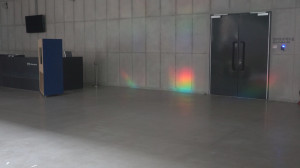
Hyun-Suk SEO, Museology, 10′, 2016 ※11/25(金)のみの上映
“[T]his industrialized museum will have much more in common with other industrialized areas of leisure—Disneyland say—than it will with the older, preindustrial museum.”
Rosalind Krauss, “The Cultural Logic of the Late Capitalist Museum”(1990)
“[T]he visual expression of this privatization has been the triumph of ‘starchitecture’: the museum’s external wrapper has become more important than its contents, just as Krauss foresaw in 1990, leaving art with the option of looking ever more lost inside gigantic post-industrial hangars, or supersizing to compete with its envelope.”
Claire Bishop, Radical Museology(2013)
Every city hosts lavish, colossal art museums as national landmarks, alluring tourists seeking earthly delights if not entirely inspirations for Instagram postings. What are the functions of art museums in this globalized world? What can art do in the age of excess and no vision? What more can we hope for beyond some “pockets of silence where we can root and grow” that Marc Rothko once hoped for, in this “time of verbiage, activity, consumption”?

Jun-Qiang NIU, When I am Getting Older With you, 5’10”, 2009 ※11/25(金)のみの上映
この作品は、単純なニュースのイメージを拡張し発展させ、レンズの背後に隠された事象や虚偽の感情を拡張する。さらに、マスメディアと現実の間のギャップを対比させ、また、私たちの生きる社会の過酷な報道とそれを避けられない状況を反映している。
意図的に感情に働きかけ、 混みあった情報を伝えるなかでも彼女は傑出した人であり、出来事の原因に柔軟な姿勢を示した。それは未熟で偏った視点で、視聴者の実生活の典型的なイメージとは違ったが、しかしまた、作り手の感情の投影であった。
生きる時間は今この瞬間ではない、映像で流れる永遠の予言はつかの間となっていく。
私のコンセプトは私たちの存在する瞬間を見つめることである。
The work develops and expands a simplex news image into the horizontal narrative, extends the hidden events and fictitious emotions behind the lens. In addition to contrast the gap between the mass media and reality, also reflects our immediate live-news demanding and the inescapable circumstance, which we live in.
Under the deliberately enlarged emotional elaborations, she stands out from the peripherally crowded news information, and the posture turns into the cause of the events. In those uncompleted and unbalanced gaze position; she is not only the epitome of the images in real life from the viewer, but also the projection of a part of emotion from the creator.
Live-time is not this moment, the eternal prophecy of the screen has become a fleeting spot. To gaze at the moment we exist is the concept of my works.

